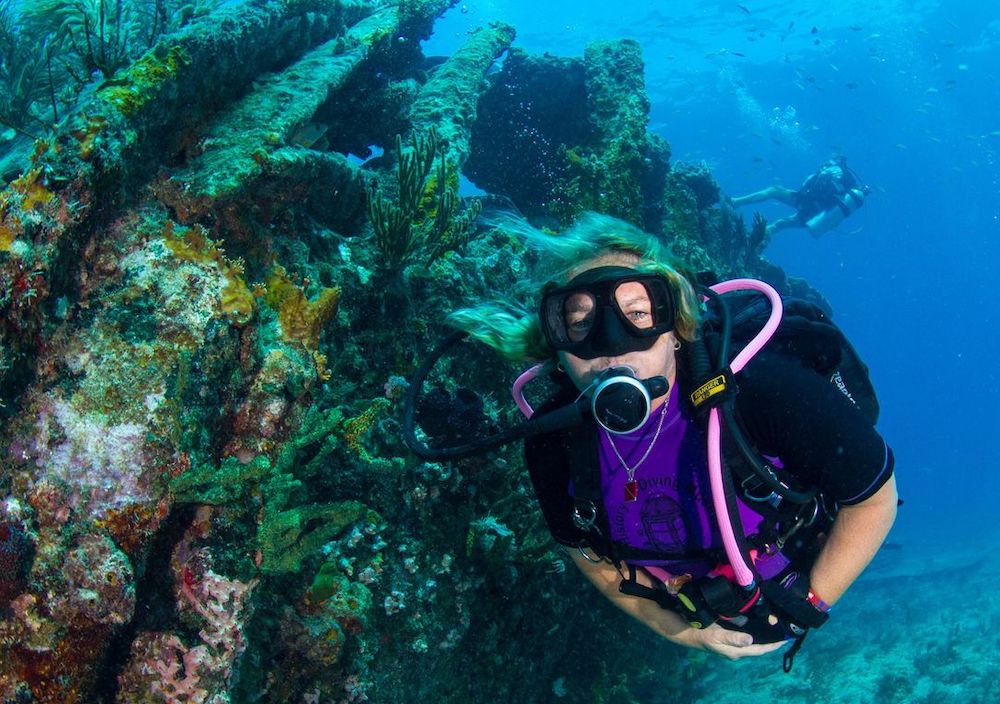In keeping with the global “Restore Our Earth” theme for Earth Day 2021 — celebrated around the world April 22 — it’s a great time to participate in meaningful, memorable water-based activities in the Florida Keys such as diving, snorkeling and even Snuba (a hybrid of the two).

Along Islmorada’s reefs, high-profile coral heads and broad ledges shelter French grunts and goatfish, while regal queen angelfish casually graze amid recesses. (Photo by Tim Grollimund)
Every day in the island chain, professional dive and snorkel operators share their knowledge and experience with people enjoying the waters within the Florida Keys National Marine Sanctuary, urging them to exercise caution and be aware of their surroundings.
The sanctuary encompasses the entire Keys and protects 2,900 square nautical miles of waters and submerged lands — including the continental United States’ only living coral barrier reef. It shelters a remarkable 6,000-plus species of marine life as well as extensive seagrass beds, mangrove-fringed islands, nationally significant marine resources, historic shipwrecks and other archaeological wonders
Late spring and summer are among the best times to explore the Florida Keys’ reefs and shipwrecks, although it’s important to practice coral reef etiquette principles anytime. So how can you do that?
Apply sunscreen that’s labeled as environmentally safe before leaving for a dive or snorkel excursion. Early application provides ideal absorption time for skin protection. Use products free of ingredients such as oxybenzone to prevent harmful chemicals from washing off in the water column and adhering to corals, effectively poisoning them.
Wear SPF clothing such as a long-sleeved rash guard, allowing you to apply less sunscreen lotion with even better sun protection.
Avoid wearing gloves, except as recommended protection if you’re touching an encrusted superstructure or mooring line while diving a shipwreck.
Divers: perform weight checks on the surface. Trim weights correctly during the dive — take weight off during the dive or redistribute the weight on either a belt or within integrated pockets in a buoyancy compensatory vest.
Control your buoyancy. Maintaining neutral buoyancy is especially important for beginner divers such as open-water students, or newly certified divers just learning to hover above a reef or the ocean bottom.

Annette Robertson explores a portion of the artificial reef Spiegel Grove in the Florida Keys National Marine Sanctuary off Key Largo. (Photo by Stephen Frink, Florida Keys News Bureau)
Use a correct swimming kick style while diving or snorkeling. Keeping your legs straight and kicking from the hips is more efficient than moving them in a circular motion that looks similar to “riding a bicycle.”
Adopt a strict “no touch” policy among marine life underwater. Touching the coral reef can be damaging. Avoid kicking the reef or standing on corals, even if they appear to be rocky.
Private boaters: practice dive flag etiquette. Properly evaluate diving conditions, slow down in an area where another vessel is displaying a dive flag, pay close attention to the direction of currents (and shifting currents), stay close to the boat, and have someone who knows how to operate the vessel remain on the boat at all times.
Use mooring buoys. Not anchoring on the reef is paramount. Many dive and snorkel sites located within the Florida Keys National Marine Sanctuary are Sanctuary Preservation Areas. Anchoring in those areas is prohibited.
When divers are educated in reef responsibility, everyone involved can benefit — and the coral reef can remain the Florida Keys’ greatest environmental treasure for generations to come.
Want to know more about practicing environmental responsibility in the Keys? Just click here to find out how to help safeguard the island chain’s unique land and water resources.

